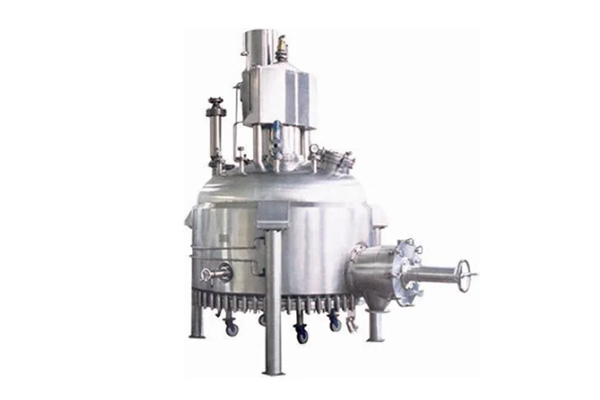WORKING
An Agitated Nutsche Filter Dryer (ANFD) combines filtration and drying in a single, closed vessel. The working principle involves introducing a mixture into the vessel, where the liquid is filtered through a porous plate while the solid cake remains on top. Agitation ensures even distribution and prevents clogging. After filtration, a washing liquid can be introduced to remove impurities, aided by the agitator to reslurry the cake. Finally, the vessel is heated (often under vacuum) to dry the washed cake, with the agitator breaking up the cake for faster, more uniform drying.
CONSTRUCTION AND FUNCTION
An Agitated Nutsche Filter Dryer (ANFD) is a piece of equipment used in chemical and pharmaceutical processes for solid-liquid separation, washing, and drying. It works by utilizing a closed vessel with a filter plate, an agitator, and heating/drying mechanisms. The principle of the ANFD involves filtering the slurry, washing the cake, and then drying the washed cake, all within the same closed system
CLOSED VESSEL
The ANFD is a pressure vessel that can be operated under vacuum or pressure. It's typically made of stainless steel or glass-lined steel for corrosive applications.
FILTER PLATE
A filter plate, often made of a mesh or sintered material, is located at the bottom of the vessel. This plate supports the filter media through which the liquid passes during filtration.
AGITATOR
A mechanical agitator is positioned within the vessel to stir and mix the slurry, ensuring even distribution and preventing the filter cake from sticking to the sides.
HEATING/DRYING MECHANISM
The vessel is equipped with a heating jacket (often steam-heated) and may also utilize vacuum to facilitate the drying of the filter cake.
WASHING SYSTEM
- The ANFD can be equipped with a washing system that allows for the removal of impurities from the filter cake using a wash liquid.
- After the liquid is filtered, washing liquid can be added to the vessel.
- The agitator reslurs the cake, ensuring thorough washing and removal of impurities.
- Once the cake is formed, a wash liquid can be introduced to remove unwanted impurities. The agitator helps reslurry the cake and ensure thorough washing.
FILTRATION
- The mixture (slurry of solids and liquid) is introduced into the vessel.
- Under pressure or vacuum, the liquid passes through the filter plate at the bottom, leaving the solid cake behind.
- The agitator helps to maintain a uniform distribution of the mixture and prevent clogging.
- The slurry is introduced into the vessel, and pressure or vacuum is applied to force the liquid through the filter media, leaving the solid cake on the filter plate.
DRYING
- The vessel is heated, often under vacuum, to evaporate the solvent and dry the filter cake.
- The agitator continuously moves the cake, breaking it up and increasing its surface area for faster, uniform drying.
- Some systems also employ pressurized nitrogen permeation for drying hygroscopic compounds.
- The vessel is heated, and sometimes vacuum is applied, to evaporate the wash liquid and dry the filter cake.
ADVANTAGE OF ANFD
Efficiency :
ANFDs combine multiple steps (filtration, washing, re-slurrying, and drying) into a single unit, streamlining the process and reducing equipment requirements.
Improved Product Quality :
The agitated action of the agitator ensures a uniform cake, preventing agglomeration and promoting even drying, leading to higher product yield and purity.
Enhanced Safety :
The closed system design reduces contamination risks, minimizes personnel exposure to hazardous materials, and enables inert gas atmospheres to be maintained during processing.
Reduced Contamination :
The closed system and integral isolator minimize contamination of the cake during scraping and removal, ensuring product purity.
Cost-Effectiveness :
Reduced equipment needs, lower labor costs, and improved efficiency contribute to overall cost savings.
Versatility :
ANFDs can handle various types of materials and adapt to different production requirements, making them suitable for a wide range of applications.
Optimized Cake Quality :
Heat transfer surfaces can be incorporated to maintain filtration temperature, optimizing cake quality and drying performance.
Faster Drying :
The agitation and heating features can significantly reduce drying time compared to traditional methods.
High Solvent Recovery :
ANFDs can recover a very high percentage of solvents, minimizing waste and environmental impact.
